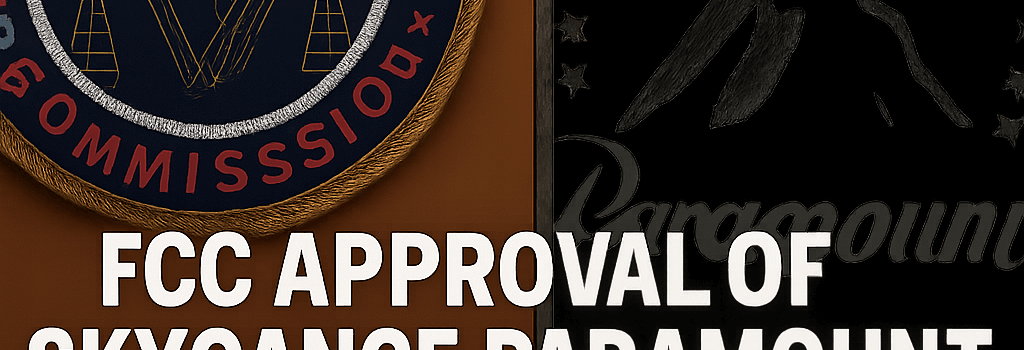FCC Approval of Skydance-Paramount Deal Sparks Free Speech Debate

The Federal Communications Commission (FCC) has granted conditional approval for Skydance Media’s $8 billion acquisition of Paramount Global, including the CBS network and its affiliated broadcast stations. The decision, finalized on July 25, 2025, has ignited fierce debate over government influence on editorial independence, First Amendment protections, and the technical and legal mechanisms of compliance monitoring.
Background and Political Context
On a 2–1 vote, FCC Chairman Brendan Carr and Commissioner Olivia Trusty green-lit the transaction after Skydance agreed to detailed written commitments intended to ensure that the merged entity’s news programming reflects a “diversity of viewpoints from across the political and ideological spectrum.” These include:
- Appointment of an independent ombudsman for two years to review bias complaints.
- Submission of quarterly bias-monitoring reports to the FCC.
- The establishment of a newsroom compliance dashboard integrated into CBS’s content management system (CMS).
Democratic Commissioner Anna Gomez issued a fiery dissent, warning that the FCC has imposed “never-before-seen controls over newsroom decisions and editorial judgment,” in violation of the First Amendment and Commission law.
Technical Mechanisms of FCC Oversight
To operationalize its oversight, the FCC has mandated the deployment of an automated bias analytics engine within CBS’s existing CMS. This engine leverages natural language processing (NLP) models—similar to those used in AI & Machine Learning applications—to flag potentially partisan phrasing, assign “tone scores,” and generate weekly audit logs.
Key technical specifications:
- Integration via RESTful APIs into the newsroom’s DAM (Digital Asset Management) system.
- Use of open-source transformer models fine-tuned for political sentiment analysis, with an accuracy target above 92%.
- Secure transport of metadata over TLS 1.3 to an FCC-hosted monitoring portal.
“We are concerned that relying on algorithmic bias detection could chill valid journalistic expression and impose unreasonable compliance costs,” said Prof. Laura Benitez, media law expert at Columbia University. “Automated tools can misclassify investigative reporting as ‘biased’ if models aren’t rigorously validated.”
Legal and Historical Precedents
Historically, the FCC’s media ownership reviews focused on market concentration and public interest obligations under the Communications Act of 1934. Direct editorial mandates have been rare, typically limited to indecency rules. This Skydance-Paramount agreement marks a notable extension of Section 310(d) authority, where the Commission conditions license transfers on content-related commitments.
Legal analysts draw parallels with the 1975 AT&T divestiture, where consent decrees shaped infrastructure commitments but did not dictate editorial policies. The current deal, by contrast, ventures into newsroom practices—raising constitutional questions now pending in multiple civil liberties lawsuits.
Implications for Broadcast Infrastructure and Compliance
Paramount’s technical operations team must now adapt its network operations center (NOC) and master control rooms to support real-time monitoring feeds to the FCC portal. This entails:
- Implementing secure gateways on broadcast distribution networks (BDNs).
- Upgrading playout servers to tag metadata at packet level (e.g., SCTE-35 markers) for segment identification.
- Allocating an estimated $1.5 billion reinvestment for IT modernization, as pledged by Skydance Chairman David Ellison.
Commissioner Trusty emphasized that these investments will enhance CBS’s resilience against cyberattacks on broadcast infrastructure, aligning with broader Cybersecurity best practices.
Expert Opinions and Industry Reaction
“Mandating technical integration of bias-detection AI is unprecedented,” noted Maya Singh, chief technology officer at MediaGuard compliance solutions. “Networks will face an ongoing compliance burden and potential false positives that they must adjudicate before the FCC.”
Veteran CBS anchor John Miller described the move as “a slippery slope,” arguing that newsroom autonomy is essential to robust investigative journalism. Meanwhile, Skydance representatives insist that editorial teams retain full day-to-day decision-making power.
Broader First Amendment Concerns
Critics fear that if accepted, these controls may serve as a template for future mergers, effectively allowing administrations to extract “ideological concessions” from media companies under the guise of public-interest conditions.
Commissioner Gomez concluded in her dissent: “Unchecked and unquestioned power has no rightful place in America. This perverse bargain erodes our foundational guarantee of a free press under the First Amendment.”
Future Outlook and Compliance Timeline
The FCC’s order stipulates a six-month window for Skydance-Paramount to deploy the compliance infrastructure and submit an initial technical report. Following implementation, the ombudsman will begin processing public complaints, with quarterly summaries made available on the FCC’s website.
Should compliance lapses occur, the FCC retains authority to impose fines under Section 503 or, in extreme cases, initiate license revocation proceedings—an escalation that media observers say would provoke immediate legal challenges.
Conclusion
The Skydance-Paramount deal represents a watershed moment for media regulation in the digital age, blending advanced AI-powered monitoring with traditional broadcast oversight. As the industry adapts, the debate over editorial independence, government power, and technological enforcement mechanisms will continue to shape the landscape of American journalism.